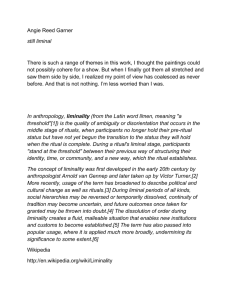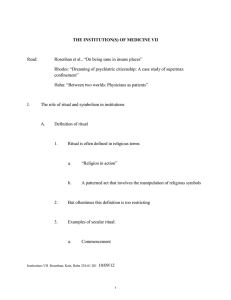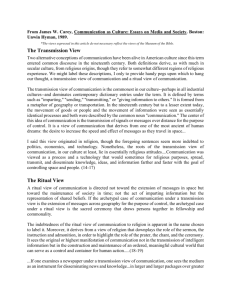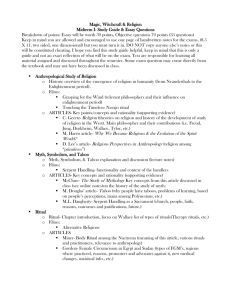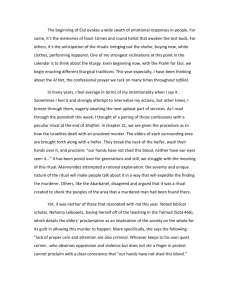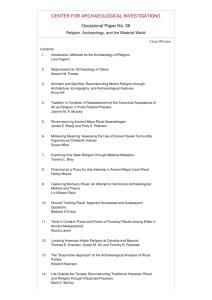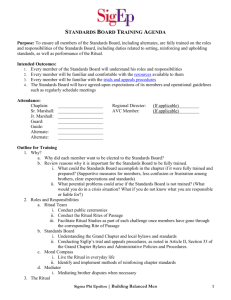Ritual in
advertisement
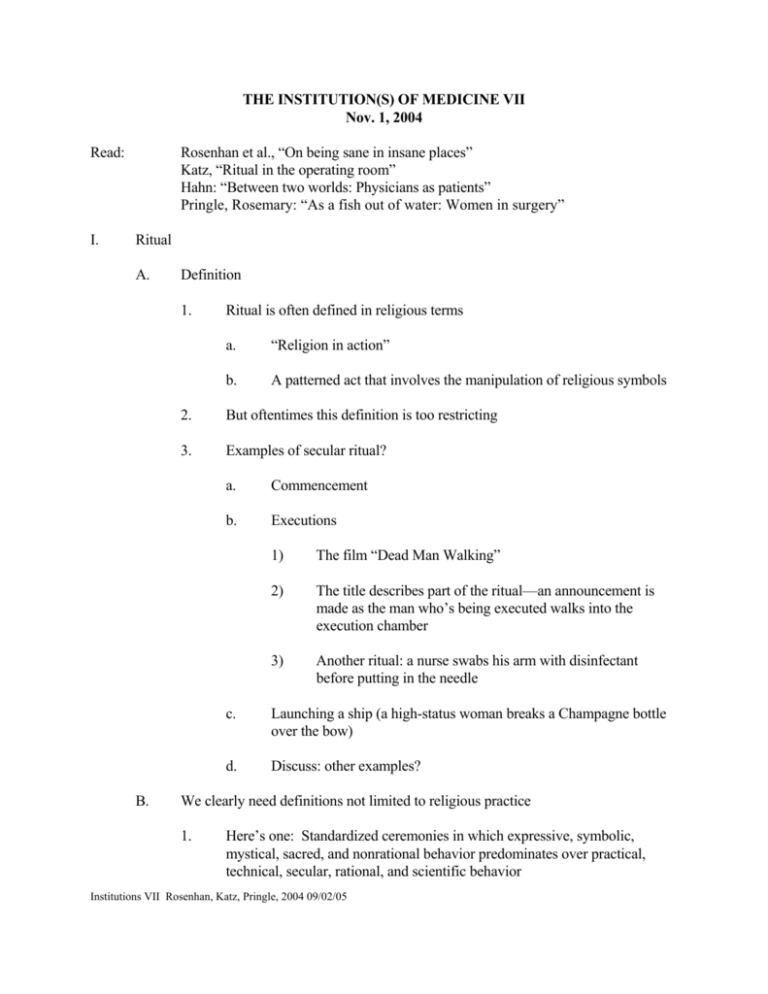
THE INSTITUTION(S) OF MEDICINE VII Nov. 1, 2004 Read: I. Rosenhan et al., “On being sane in insane places” Katz, “Ritual in the operating room” Hahn: “Between two worlds: Physicians as patients” Pringle, Rosemary: “As a fish out of water: Women in surgery” Ritual A. Definition 1. B. Ritual is often defined in religious terms a. “Religion in action” b. A patterned act that involves the manipulation of religious symbols 2. But oftentimes this definition is too restricting 3. Examples of secular ritual? a. Commencement b. Executions 1) The film “Dead Man Walking” 2) The title describes part of the ritual—an announcement is made as the man who’s being executed walks into the execution chamber 3) Another ritual: a nurse swabs his arm with disinfectant before putting in the needle c. Launching a ship (a high-status woman breaks a Champagne bottle over the bow) d. Discuss: other examples? We clearly need definitions not limited to religious practice 1. Here’s one: Standardized ceremonies in which expressive, symbolic, mystical, sacred, and nonrational behavior predominates over practical, technical, secular, rational, and scientific behavior Institutions VII Rosenhan, Katz, Pringle, 2004 09/02/05 2 2. But there are problems with definitions that seem to dismiss ritual as superfluous, irrational, unscientific 3. So, let’s stay with the idea of patterned behavior 4. And then add that rituals require shared understandings about what the behavior consists of, and why it’s done 5. And add that rituals occur in social situations a. C. If you want to call brushing your teeth a ritual, fine, but that’s not the prototypical ritual What do rituals do? 1. 2. Accomplish things a. Properly launch a ship, execute a man, expel a cadet from West Point b. Some rituals properly move people from one social status to another 1) These rituals are called “rites of passage” 2) Commencement, Bar/Bat mitzvah, “sweet sixteen” birthday parties, weddings, funerals, joining the army Rituals also are occasions where members of a society make statements about society a. About what’s important; about what’s beautiful, what’s moral, etc. b. Some of the communications are entirely intended; participants are utterly aware of them 1) c. “I dub thee Sir Paul McCartney” Some of the communications are sent unconsciously 1) If you’re a social scientist, making claims about what is being said unintentionally is tricky 2) Your evidence is not as strong 3 D. But it’s very clear that rituals contain hidden meanings 4) Such unconscious meaning may be mainly psychological, or social a) Example: Gordon’s analysis of hospital slang b) Psychological—“venting” c) Psychological—affirmation of “in group” d) Social—sending messages about the social status of participants Rituals in modern operating rooms are stylized, arbitrary, repetitive and exaggerated forms of behavior 1. II. 3) What are Katz’s hypotheses about ritual in an operating room? a. That rituals serve some very practical functions b. Operating room ritual contributes to the efficiency of a technical, goal-oriented, scientific activity such as surgery, by permitting autonomy of action to the participants and enabling them to function in circumstances of ambiguity c. They make salient, and even exaggerate, the boundaries of categories in a situation of potential confusion d. Operating room ritual establishes the discontinuous nature of the operating room and its activity from the rest of the hospital and world e. The ritual permits diffusion of emotions Liminality A. Katz talks about it B. “Liminality” refers to “betwixt and between” objects or states—neither “fish nor fowl” 1. Examples: Twilight, lungfish; swamps 4 C. Katz mentions anthropologists Arnold Van Gennep, Mary Douglas, Victor Turner 1. These 3 authors talk about periods of transitions being seen as special, often dangerous, in all societies 2. There is lots of cross-cultural evidence that people in transition are indeed seen this way, even those that are kind of “permanently” in transition a. 3. Such as hermaphrodites The hypothesis is that we are made nervous by “betwixt and between” cases a. Situations in which the classification of objects or people is not clear are also often seen as dangerous or problematic in some way b. Such objects or people are often said to be 1) Polluted 2) Sacred 3) To have special powers 4. The argument is that ritual is so prominent in situations of liminality because it is seen to control the danger 5. Some of the tasks that rituals accomplish are either to strongly mark boundaries, or create them when they aren’t there a. Carrying the bride over the threshold makes a ritual statement that the threshold (the boundary between outside the house and inside the house) is being crossed b. Classic case of liminality—the threshold is “betwixt and between” d. Discuss: what is the ritual saying? e. Are the bride and groom aware that this is the meaning of the ritual they’re engaging in? 5 III. Medicine and liminality A. Organ transplants provide occasions for exploring ways societies deal with liminality 1. “Betwixt and between” again 2. We see cannibalism as horrible 3. 4. 1 a. Even when we learn about cultures prescribing cannibalism where no killing is involved and the dead person wanted to be incorporated into his/her descendants b. Note that “medicinal cannibalism” has been documented in European medical literature since the first century A.D., mentioned by Pliny the Elder 1) Who spoke about human blood as a cure for epilepsy 2) Substances from human corpses to treat arthritis, reproductive difficulties, sciatica, warts, skin blemishes 3) Blood most effective when drunk immediately after the death of the person, and blood of those who died violently was seen to be especially potent 4) In the heyday, human body products were regular items in any well-stocked pharmacy 1 If you’re cut open and a part of someone else is put in a. How is this not like cannibalism? b. It’s less upsetting than if you were to ingest a part c. It’s still not totally OK, as transplant recipients’ comments make clear The Christian ritual of communion Beth A. Conklin: Consuming Grief: Compassionate Cannibalism in an Amazonian Society. Austin: University of Texas Press, 2001: 8-10. 6 B. Communion involves symbolically or actually (Catholicism— doctrine of transubstantiation) taking in the body and blood of Jesus Christ b. A ritual that appropriates the disturbing quality of incorporation of another’s body to make powerful positive statements c. It’s a kind of cannibalism d. Ingestion of human flesh and blood, but with totally different meanings—this is a blessing, a sacrament, promotes spiritual health Liminality in surrogacy 1. C. a. “That woman is carrying my baby; isn’t she supposed to be my wife?” Our readings offer examples of liminality 1. Katz’s examples of making strong statements about boundaries—which seem arbitrary a. 2. Rosenhan et al.: people inside a mental hospital playing the role of patients are by definition insane 3. Women surgeons: “honorary men” a. 4. 5. Are in a liminal space to some degree All of Dumit’s “new socio-medical disorders” reveal all kinds of classificatory problems, liminality a. “Biomental,” for example Hahn’s physicians as patients: probably some of the unfortunate reactions and treatments experienced by these seriously ill physicians a. IV. Above the waist, below the waist? Occur because of the improper boundary-crossing they engaged in Ritual meanings A. Oftentimes metaphors are abundantly employed 7 1. Symbols showing transitions from other domains are used: 2. The ritual that moves a person from Y status to X status will often use birth imagery to make a statement about what is happening, and heighten the emotional impact of the ritual on the audience 3. Christian conversion: “Ye must be born again”—and some denominations specify baptism as an adult
